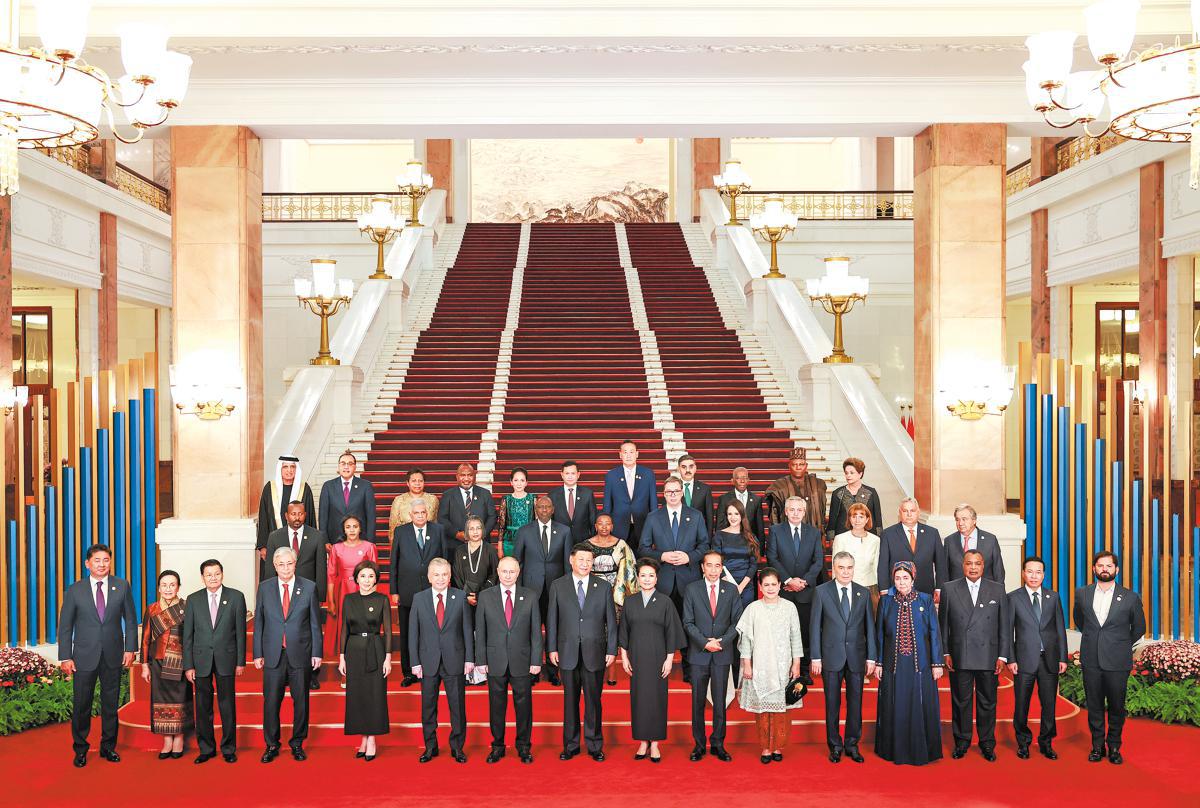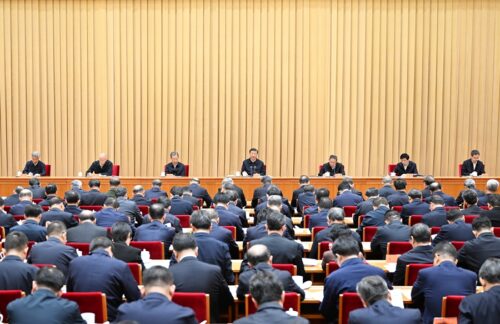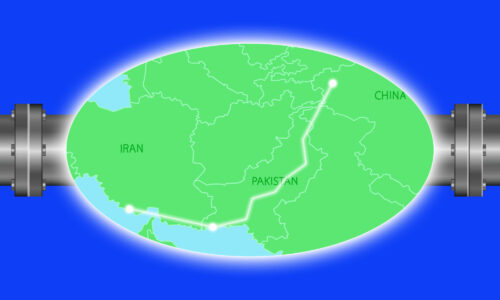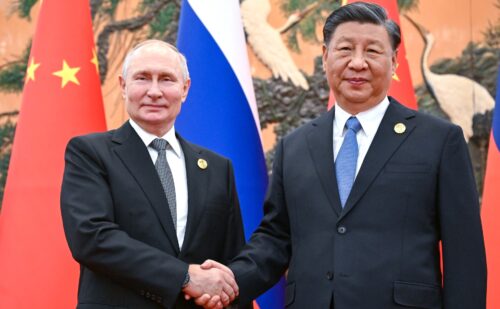Surprise attendees, notable absences, and Vladimir Putin at the Belt and Road Forum
The third Belt and Road Forum concluded on Wednesday. During the two-day forum, Chinese President Xi Jinping sought to frame the Belt and Road Initiative as part of a greater struggle against colonialism and developmental injustice.

The third Belt and Road Forum for International Cooperation (BRF), held in Beijing on Tuesday and Wednesday, drew to a close without the “Leader’s Roundtable” and joint communique that rounded off previous forums held in 2017 and 2019. The omission could be owing to other world leaders’ reluctance to issue a joint statement with Russian President Vladimir Putin, who is wanted by the International Criminal Court (ICC) for war crimes in Ukraine.
Putin was the guest of honor at the forum, seated front and center during Xí Jìnpíng’s 习近平 opening remarks and given more than 10 minutes to speak following Xi.
The third BRF was not nearly as well attended as the 2019 forum, which saw a record showing of 36 heads of state and government. Twenty-nine heads of state or government attended the first BRF, and just 22 leaders showed for this year’s edition.
Chinese media claims that “representatives” from over 140 countries attended, but that tally includes everyone from ministers to journalists. Beijing may have been able to pack the room with a record number of attendees, but the BRI family photo, consisting of top-level dignitaries, looked a little lonely this year.
However, the poor showing doesn’t entirely reflect on the BRI’s popularity. The Israel-Hamas war probably impacted high-level attendance from the Gulf, and after attending the Asian Games in September, it may have been too soon for some leaders to make a return trip to China. Additionally, even if the EU hadn’t fallen out of love with the BRI, it is likely that top-level European representation would have stayed away from the summit due to the presence of Putin. China’s two stalwart allies in Europe, Serbia’s Aleksandar Vučić and Hungary’s Viktor Orban, however, did attend, as they did for each of the last two.
Notable absences include:
- Greece, the Czech Republic, Italy, and Switzerland all sent leaders to the previous two forums, but decided to skip this year.
- The leaders of the Central Asian republics Kyrgyzstan and Tajikistan could not find the time to come — despite the surprise first-time attendance of Turkmenistan’s “National Leader” Gurbanguly Berdimuhamedow and top-level attendance from Kazakhstan and Uzbekistan.
- Malaysia, Myanmar, and the Philippines also failed to send heads of state or government for the first time, though Myanmar’s lack of representation is likely owing to the 2021 coup d’etat.
- For the first time, the International Monetary Fund (IMF) did not send a director to the forum, though the head of the New Development Bank (NDB), Dilma Rousseff, did get a front-row seat, perhaps signaling Beijing’s confidence in the new international order it is seeking to forge among countries of the “Global South.”
Thirteen countries have managed to send heads of state or government to all three BRFs: Chile, Ethiopia, Hungary, Indonesia, Kazakhstan, Kenya, Laos, Mongolia, Pakistan, Russia, Serbia, Uzbekistan, and Vietnam. The United Nations Secretary General has also always attended.
Xi Jinping’s opening remarks
Xi delivered his longest BRF keynote speech yet (English text here, Chinese here), and for the first time did not open with a remark about the weather.
Xi’s opening speech at the second BRF focused on a series of promises to reform the Chinese economy and take measures to “boost higher-quality opening up.” At this year’s forum, Xi’s speech was concentrated on China’s global leadership role. Xi put forward “eight major steps” China will take to boost “high-quality Belt and Road cooperation.”
The speech went even further than usual in framing China as a peaceful, cooperative international actor, represented by the “Silk Road spirit of peace and cooperation, openness, and inclusiveness.” In his speech, Xi brings China’s competition with the “West” into the BRI equation, declaring: “Ideological confrontation, geopolitical rivalry, and bloc politics are not a choice for us. What we stand against are unilateral sanctions, economic coercion and decoupling, and supply chain disruption” (per the official translation).
The imagery Xi deployed clearly set China and the BRI up in opposition to unnamed, bellicose colonizers. “The pioneers of the ancient silk routes,” he told his audience, did not win their “place in history” as “conquerors with warships, guns, horses, or swords.”
The main message Xi was hoping to land was that “the modernization we are pursuing is not for China alone.” The subtext here is that powers like the U.S. seek to keep others down and perpetuate inequalities. The rhetoric is not new to Chinese foreign policy, but it marks a clearer framing of the BRI as part of China’s leadership efforts to help the Global South in the struggle against colonialism and developmental injustice.
The Belt and Road white paper Beijing published in the run-up to the BRF also makes this point clearly: “The BRI is committed to building a prosperous future that diverges from the exploitative colonialism of the past, avoids coercive and one-sided transactions, rejects the center-periphery model of dependency, and refuses to displace crisis onto others or exploit neighbors for self-interest.”
In his speech, Xi also stressed “open, green, and clean cooperation, and the goal of pursuing high-standard, people-centered, and sustainable cooperation.” The sustainability rhetoric is not new (Xi talks of “green, open, and inclusive development” in his 2017 BRF speech), but the BRI is increasingly framed in terms that are designed to please the international development community.
“Small and beautiful” also makes an appearance, though this is now translated in the English version as “small, yet smart.” Alongside a focus on digital and green development, “small and beautiful” is now the accepted definition of BRI 2.0 — at least on paper. “Small and beautiful” is a phrase that Xi started promoting in 2021 to describe smaller-scale projects that look more like traditional foreign aid projects.
Xi also claims in his speech that “Belt and Road cooperation has expanded from physical connectivity to institutional connectivity.” At the moment, there is limited institutional reality to the BRI, though perhaps this reflects a wish for the BRI to lead more through institutional cooperation than expensive, hard infrastructure projects.
Tangible results
Alongside a statement from the BRF chairman that elaborates on Xi’s talking points, Beijing has also published a list of 89 multilateral cooperation documents and a list of 458 “practical cooperation projects.” Although Foreign Minister Wáng Yì 王毅 boasts that this list is far larger than previous forums, few of the 458 “practical” projects are substantial, and the list consists of items like the signing of “an action plan on building a China-Laos community with a shared future,” as well as already completed projects.
The most interesting items were already foregrounded in Xi Jinping’s opening speech, including a “Global Artificial Intelligence Governance Initiative” that is explicitly grouped with Beijing’s other new initiatives — the Global Development Initiative, the Global Security Initiative, and the Global Civilization Initiative. The new AI initiative opposes “drawing ideological lines or forming exclusive groups to obstruct other countries from developing AI,” and comes a day after Washington moved to limit China’s access to more advanced chips, suggesting that, like the GSI and GCI, it is mainly about countering the U.S.
The list also includes several financial commitments: a 350 billion yuan ($48 billion) financing window from both the China Development Bank (CDB) and Export-Import Bank of China, as well as a top-up of 80 billion yuan ($11 billion) for the Silk Road Fund. In his speech, Xi also mentioned “cooperation agreements worth $97.2 billion” that were reportedly signed at a “CEO conference” during the forum, though it is unclear which agreements this refers to.
Besides public relations for the Belt and Road, the main value of the BRF lies in the opportunity for Xi to meet so many world leaders. The meeting with Putin is certainly the one that the West was watching most closely, but China also signed a free-trade agreement with Serbia and elevated ties with Ethiopia to those of an “all-weather strategic partnership” — a level of relations reserved for the likes of Pakistan and Belarus.






